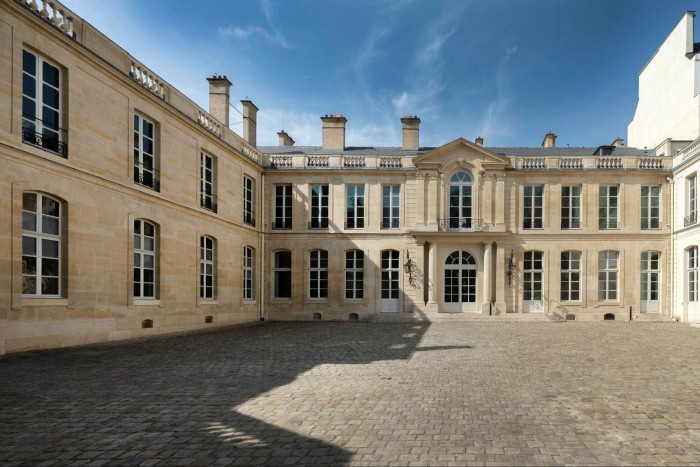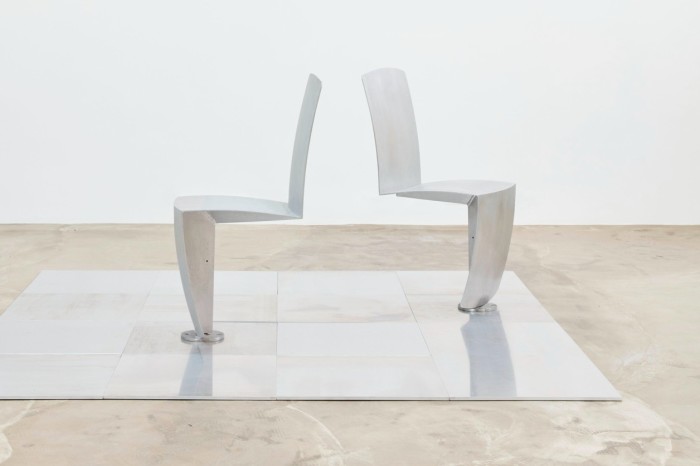Design Miami makes its Paris debut, with help from Brexit

Roula Khalaf, Editor of the FT, selects her favourite stories in this weekly newsletter.
Next week, and just a year late, Design Miami will open its first fair in Paris. What was originally devised to take place in a tent in the Place de la Concorde in 2022 will instead appear in a spectacular 18th-century hôtel particulier just a block south of the Musée d’Orsay. The Hôtel de Maisons offers nearly 11,000 sq ft of gilded and panelled interior space and a vast formal garden. Both will be filled with design artefacts from the early 20th century to the present day, on offer from 27 galleries.
According to Jen Roberts, Design Miami’s chief executive, the company had been eyeing up Paris for a while but decided to commit once Art Basel announced its first fair in the city for October. “We were sure it would all happen last year until we received a notice at the end of July to say the venue was no longer viable,” says Roberts. Partly to blame were unruly scenes following a football match, which made the police nervous about introducing more activity around a site as central as Concorde. This year, after they had looked at 48 possible locations, the Hôtel de Maisons appeared as a last-minute option. “My team said, ‘It’s a fabulous house! Don’t walk, run!’”

The house is indeed so fabulous that, from 1977 until 2007, when still under the ownership of the Pozzo di Borgo family (a name by which is sometimes known), it was home to Karl Lagerfeld. He lived there in extraordinary eclectic splendour, surrounded by historical tapestries and bronzes as well as contemporary works by Konstantin Grcic and Martin Szekely.
“It’s not going to be easy to install our pieces there,” says gallerist Jacques Lacoste, the city’s leading specialist in the haute bourgeois works of mid-century designer Jean Royère. “We can’t put anything on the walls or hang anything from the ceiling. But it is a mini-Versailles.”
Some, though, have lucked out. “We’ve been told we’re showing in Karl’s former bedroom,” says Paul Bourdet, who runs a gallery with his partner Charlotte Ketabi. The pair specialise in 1980s French design. “For us this work, by Philippe Starck, for example, is already historic. It’s sculptural and radical, and we’re excited to show how well it fits into this uniquely Parisian decor.”

In the Hôtel de Maisons’ very large garden galleries will be able to show outdoor works, some with unique connections to the city. For Ketabi Bourdet, this means a pair of aluminium chairs designed by Starck in 1984 for the Parc de la Villette in Paris. The originals are still there, and other examples are rare. Edward Mitterrand, who is a specialist in the work of Claude and François-Xavier Lalanne, known for their large sculptural renditions of animals, will be exhibiting the latter’s “Âne attelé” (Donkey in harness), equipped with a cart-cum-planter, conceived in 1989 for the parc Georges-Brassens. “Les Lalannes,” says Mitterand, “have become icons of French design around the world, particularly in Asia. But I would love this piece to stay in France.”

Design Miami’s first manifestation was in December 2005 and timed to coincide with Art Basel Miami Beach. At the time, co-founder Craig Robins was busy developing Miami’s Design District, converting an unloved quarter into an outdoor experience synonymous with high French fashion. By bringing the fair to Paris, Robins is reinforcing this Franco-American alliance. “Our relationship to the luxury world is paramount,” he says.
While London is a vibrant place for contemporary design, Paris is the older sibling, where blue-chip design galleries proliferate on both banks of the Seine. They are the guardians of major French design legacies — Royère, Jean Prouvé, Charlotte Perriand, Georges Jouve, Pierre Paulin and living designers such as Starck and Szekely. “There is a diversity of museums focused on decorative arts, huge numbers of interior designers,” says Simon Andrews, a design expert who worked at Christie’s for 26 years. “And then there is the colossal flea market in Clignancourt. I can’t think of another city in the world with this level of [design] dealers and galleries.”

London had nonetheless been a key design hub until Brexit landed a 20 per cent import tax on goods from Europe. “A vast quantity [of design] would come into London, and 60 per cent upwards would be spread out again to the US and Asia,” says Andrews. “But there has been an inevitable retraction since Brexit. Paris has the infrastructure and the appetite and the capacity to absorb the material and disseminate it.”
Marc Benda, a director at the US gallery Friedman Benda, says the intellectual approach to design that prevails in Paris underpinned his gallery’s decision to open a space there. In 2024, Friedman Benda will unveil a lofty space in the Marais that once sold Lee jeans, just a short walk from the Centre Pompidou. Meanwhile, at Design Miami it will show works by contemporary designers, including the Dutch Joris Laarman, British Samuel Ross and American Misha Kahn, who do not as yet have a profile in France. “We’ve created a major presence for these artists in the US,” says Benda. “Now we can do the same for them in Europe.”
October 18-22, designmiami.com

Comments